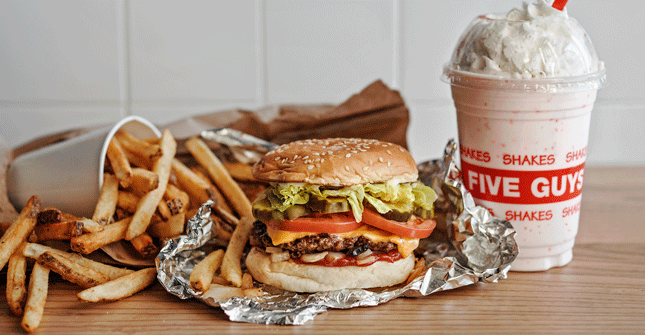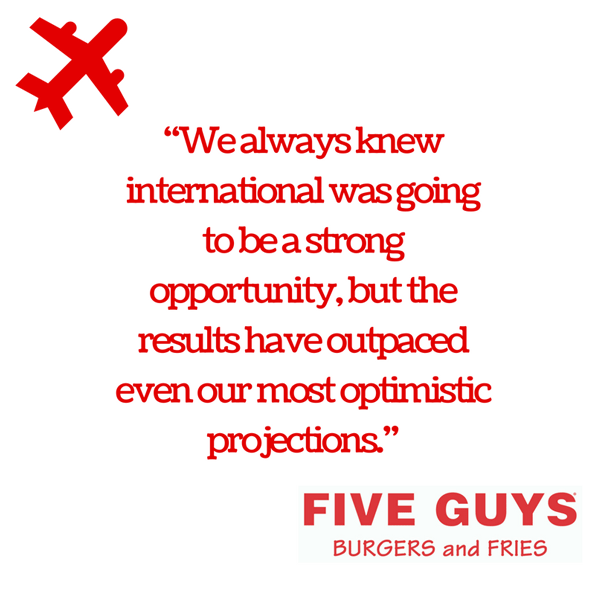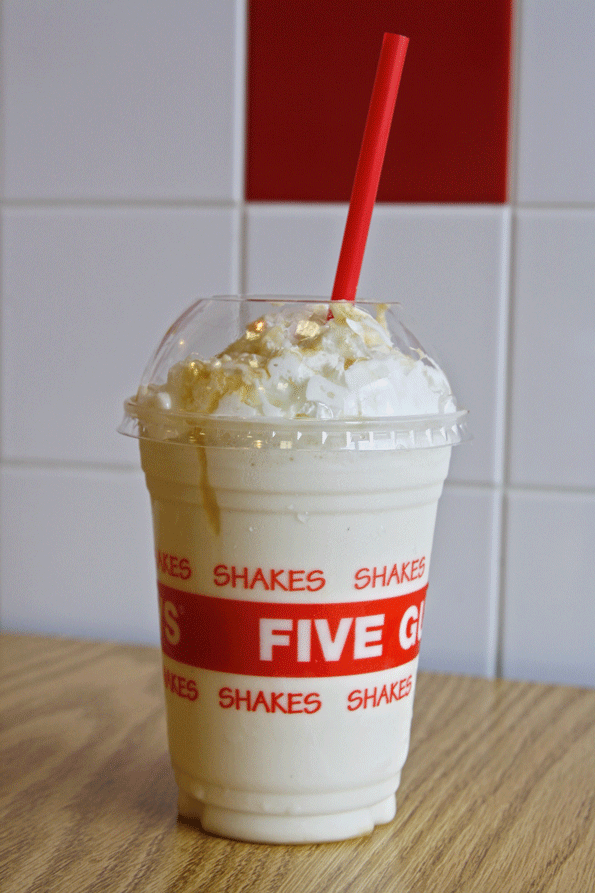
Virginia-based Five Guys has long prided itself on a menu that is so simple it originally missed an element considered vital for burger chains: Milkshakes.
Indeed, one of the company’s executives had famously told a conference audience that the chain would “never” add shakes to its menu.
“Never” arrived in 2014 when Five Guys began testing shakes in some markets after a franchisee showed they’d work in his own stores.
The company has been gradually adding shakes at more locations ever since. Today, 800 of the chain’s 1,400 units have shakes, including all the new ones.
“Why didn’t you make us do this earlier?” founder Jerry Murrell said in an interview with NRN this week. “It’s been big-time for us.”
Shakes aren’t the only thing Five Guys is using to spur growth. The company is developing more locations in international countries.
 In the last three years, Five Guys has found fertile ground in Europe and the Middle East, and is now turning to Asia and Australia for new development to build on that success. The company expects to expand its international footprint from eight countries to more than 30 over the next five years.
In the last three years, Five Guys has found fertile ground in Europe and the Middle East, and is now turning to Asia and Australia for new development to build on that success. The company expects to expand its international footprint from eight countries to more than 30 over the next five years.
“We always knew international was going to be a strong opportunity,” Five Guys Chief Operating Officer Sam Chamberlain said in a media statement, “but the results have outpaced even our most optimistic projections.”
Five Guys led the emergence of the so-called better burger segment with explosive growth in 2009, 2010 and 2011 in spite of a weak restaurant market that struggled to recover from the recession.
The company’s growth has slowed more recently, and competitors have flooded the market.
Shake Shack Inc. and Habit Burger Inc. have grown rapidly and recently had initial public offerings. Rival Smashburger continues to grow and received an investment from Philippines-based operator Jollibee Foods Corp. Chipotle Mexican Grill Inc. is planning its own entrance into the market.
Still, while Five Guys’ growth has slowed, it hasn’t stopped, and the company remains, by far, the biggest of the better burger category, adding a total of about 100 locations a year. Estimated unit volumes rose nearly 5 percent last year to just over $1.1 million, according to NRN’s Top 100 data. Domestic systemwide sales rose 9 percent to $1.3 billion last year.
“We still own over 50 percent of the burger market,” Murrell said. “We intend to keep that.”
Sales in the global market

All of the chain’s new locations and international locations have shakes.
And shakes are providing an additional sales vehicle to go with its burgers and fries.
Five Guys has avoided shakes, in spite of its traditional popularity in the burger world, largely because it wanted to do them the right way.
A franchisee spent $200,000 of his own money to add shakes at his own stores. The company then used a select group of operators to test it out.
“We only wanted to do shakes if we could do it right,” Murrell said. “We didn’t think we could do it.”
“I didn’t want a cheap shake,” he added. “I wanted a good shake.”
International growth makes a lot of sense for restaurant chains in the current market. The domestic restaurant business is largely saturated; weak same-store sales growth in the industry so far in 2016 in spite of a strong economy indicates a saturated market.
Burgers are increasingly popular overseas. And Five Guys is taking advantage of that trend with its menu of burgers, fries and shakes. Murrell, in fact, said part of the chain’s success in overseas markets is due to its refusal to stray from simplicity.
“We’re not the smartest business people in the world so we just keep things simple,” Murrell said. “We’ve been lucky.”

The chain has more than 50 locations in the United Kingdom since opening its first location in London in 2013. And in the past year it has opened in five new markets: Ireland, United Arab Emirates, Saudi Arabia, Kuwait and France. The company says average unit volumes in new markets are five to seven times its domestic locations.
The chain’s strongest locations are in Britain, France and the Middle East. Five locations in Central London generate between $5 million and $10 million a year.
A location in Paris is on track to generate $10 million. That’s about 10 times the average unit volume of Five Guys’ domestic locations.
“We’re building bigger stores, more special stores,” Murrell said. “In the United States, most of our stores are end caps. Over there, it’s a lot of free-standing stuff.”
The company now wants to target the Far East, though it is staying away from China, at least for now, as it focuses on places like Japan and South Korea. “I’m getting pulled so hard by China,” Murrell said. “Everybody wants us. But we’re still going to do Japan and South Korea first.”
Contact Jonathan Maze at [email protected]
Follow him on Twitter at @jonathanmaze




